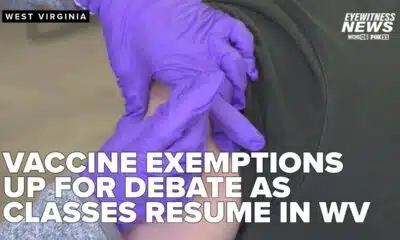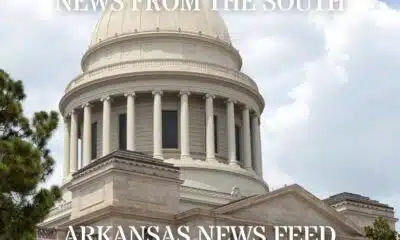News from the South - West Virginia News Feed
Trump wants to cut Head Start. In WV, it will eliminate preschool for 8K kids and thousands of jobs.
by Amelia Ferrell Knisely, West Virginia Watch
May 1, 2025
Samantha Casto, a preschool teacher at Ravenswood Head Start, is making the outdoors her classroom this spring. Her four- and five-year-old students are learning about bug habitats and digging their tiny hands into the dirt.
“It’s not ‘sit down at a desk and learn,’” said Casto, 33. “They get to learn in a fun way.”
Head Start offers free child care, early education, meals and more to thousands of low-income children in West Virginia. There are support services for families, as well.
Under President Donald Trump, the program could be terminated.
The Trump administration is asking Congress to eliminate funding for Head Start, which would shutter programs nationwide.
In West Virginia, it would terminate preschool and services for nearly 8,000 children and cut 3,000 jobs.
“I can’t imagine how West Virginia would fare — our children, families, even our economy … I don’t know how these families would go to work,” said Lori Milam, executive director of the West Virginia Head Start Association. “It would be devastating. It really would.”
Casto has worked at Ravenswood Head Start for 11 years. “I’m devastated and upset,” she said.
The Trump administration has already slashed Head Start staff, closed half the program’s regional offices and delayed funding.
Several states, including Pennsylvania, and advocacy groups are suing the Trump administration over the looming Head Start funding cuts. The lawsuit alleges that the actions already taken against the program, including shuttering its regional offices, required congressional approval.
Milam said West Virginia Head Start is waiting on grant money needed May 1 for programs that serve 1,000 children.
“There’s no communication because of closing the [regional] Head Start offices,” she said.
A spokesperson for U.S. Sen. Shelley Moore Capito, R-W.Va., said in an email, “At this point in time, Sen. Capito is continuing to work with [the U.S. Department of Health and Human Services] to ensure that West Virginia Head Start centers receive their grant money.”
Sen. Jim Justice, R-W.Va., Rep. Carol Miller, R-W.Va., and Rep. Riley Moore, R-W.Va., did not return comments for this story.
West Virginia’s Head Start programs are solely reliant on federal funding and received $83 million in 2024.
State Sen. Laura Chapman, who chairs the Senate Health Committee, said she would see if the state could fund the program should the federal cuts go through.
“A cut to Head Start would be devastating, however, I do support the Trump administration’s goals in reducing bureaucracy and administrative costs,” said Chapman, R-Ohio. “If it does happen, I believe that the state should step up and try to fill in the gaps.”
“I support Head Start and our families,” she added.
Head Start closure would worsen state’s child care shortage
Head Start’s potential closure would worsen the state’s child care shortage. More than 25,000 children in West Virginia don’t have access to child care, and hundreds of child care facilities have closed in the state in the last few years.
Northern Panhandle Head Start serves five counties, including Wetzel County, where there is no licensed child care center. The program partners with five nearby child care centers to provide funds that help pay teachers.
“Our Head Start [programs] are some of the only available centers that children can go to,” said Jackie Bell, executive director of Northern Panhandle Head Start. “I’m very concerned about the proposed budget cuts. It threatens the stability and the future of our early childhood education.”
“We’re more than a preschool program,” she continued. “It allows [families] to go out and get jobs and work during the day and know their child is taking care of and receiving quality programming.”
Bell said 120 staff will lose their jobs if her Head Start program is forced to close.
The National Institute for Early Education Research recently ranked West Virginia as fourth in the nation for preschool for four-year-olds, which was influenced by Head Start access statewide.
Head Start also serves a referral program, connecting young children with free services like speech and physical therapy through the Birth to Three program. Milam worries that children, including children in foster care and those with developmental disabilities, will slip through the cracks without screenings and services before they enter kindergarten.
Program employees also made nearly 44,000 home visits last year to check on children and provide in-home support for parents. The service plays a role in preventing children from entering West Virginia’s overburdened foster care system, Bell said.
“One of the unique pieces of our program is the parent education and training side of it,” Bell said, adding that the organization also makes referrals to Child Protective Services when necessary.
“We’re serving the vulnerable children and families, and that’s what’s really scary about these potential cuts,” she said.
Milam planned on spending this year celebrating Head Start’s 60th anniversary. Now, she is collecting testimonials and calling elected officials in hopes of saving the program.
“I am still very, very hopeful,” she said.
Savannah Shamblin, 32, is a Head Start teacher at the Fairplain Center in Jackson County. Her students are learning the alphabet, how to spell their names and how to use silverware.
“Whenever that clicks, I get super excited … because I know I’m making a difference, and the kids get excited too,” she said.
Shamblin is worried about her job, but said, “I worry more about the children and families more.”
“We need to continue it for the next 100 years because it’s helping children that really need it,” she said.
YOU MAKE OUR WORK POSSIBLE.
West Virginia Watch is part of States Newsroom, a nonprofit news network supported by grants and a coalition of donors as a 501c(3) public charity. West Virginia Watch maintains editorial independence. Contact Editor Leann Ray for questions: info@westvirginiawatch.com.
The post Trump wants to cut Head Start. In WV, it will eliminate preschool for 8K kids and thousands of jobs. appeared first on westvirginiawatch.com
Note: The following A.I. based commentary is not part of the original article, reproduced above, but is offered in the hopes that it will promote greater media literacy and critical thinking, by making any potential bias more visible to the reader –Staff Editor.
Political Bias Rating: Center-Left
The article provides a factual overview of proposed cuts to the Head Start program, which would impact thousands of children and workers in West Virginia. While the content largely focuses on the negative consequences of these cuts, including direct quotes from individuals affected by the policy and concerns about its broader social and economic effects, it does not overtly promote an ideological position. The piece tends to present the issue from the perspective of those who would be harmed by the cuts, including educators and advocates for low-income families. The tone, particularly in phrases like “devastating” and “slashing,” suggests a sympathetic view toward the program and those it serves, but it remains largely grounded in reporting on the actions of the Trump administration and its impact on specific communities. The article refrains from offering overt support for political alternatives or opposition, maintaining a focus on human impact rather than explicitly advocating for one policy stance over another.
News from the South - West Virginia News Feed
WEEKEND WEATHER AUG 24TH
SUMMARY: WEEKEND WEATHER AUG 24TH: Today was a pleasant, typical summer day with temperatures reaching 80° in Beckley. A cold front is moving through tonight, bringing increasingly breezy winds and cooler air, dropping temps to the high 50s overnight and into the 40s early next week. Rain chances remain very low, with mainly dry conditions expected tonight and tomorrow. Monday will feature a mix of clouds and sun with highs in the high 60s to low 70s—cooler than normal. Low humidity and comfortable weather will continue through the week, making it a great time to enjoy the outdoors as fall arrives early.
FOLLOW US ON FACEBOOK AND TWITTER:
https://facebook.com/WOAYNewsWatch
https://twitter.com/WOAYNewsWatch
News from the South - West Virginia News Feed
Feds direct states to check immigration status of their Medicaid enrollees
by Anna Claire Vollers, West Virginia Watch
August 22, 2025
This week, the Trump administration’s Centers for Medicare & Medicaid Services (CMS) announced an effort to check the immigration status of people who get their health insurance through Medicaid and the Children’s Health Insurance Program.
Medicaid is the public health insurance program for people with low incomes that’s jointly funded by states and the federal government. For families that earn too much to qualify for Medicaid but not enough to afford private insurance, CHIP is a public program that provides low-cost health coverage for their children.
The feds will begin sending states monthly enrollment reports that identify people with Medicaid or CHIP whose immigration or citizenship status can’t be confirmed through federal databases. States are then responsible for verifying the citizenship or immigration status of individuals in those reports. States are expected to take “appropriate actions when necessary, including adjusting coverage or enforcing non-citizen eligibility rules,” according to a CMS press release.
“We are tightening oversight of enrollment to safeguard taxpayer dollars and guarantee that these vital programs serve only those who are truly eligible under the law,” Robert F. Kennedy Jr., who oversees CMS as secretary of the U.S. Department of Health and Human Services, said in a press release announcing the new program.
As of April, roughly 71 million adults and children nationwide have Medicaid coverage, while another 7 million children have insurance through CHIP. Immigrants under age 65 are less likely to be covered by Medicaid than U.S.-born citizens, according to an analysis from health research organization KFF.
Immigrants who are in the country illegally aren’t eligible for federally funded Medicaid and CHIP. Only citizens and certain lawfully present immigrants — green card holders and refugees, for example — can qualify.
But some states have chosen to expand Medicaid coverage for immigrants with their own funds. Twenty-three states offer pregnancy-related care regardless of citizenship or immigration status, according to KFF. Fourteen states provide coverage for children in low-income families regardless of immigration status, while seven states offer coverage to some adults regardless of status.
The tax and spending package President Donald Trump last month cuts federal spending on Medicaid by more than $1 trillion, leaving states to either make up the difference with their own funds or reduce coverage. But the new law also includes restrictions on coverage for certain immigrants, including stripping eligibility from refugees and asylum-seekers.
Stateline reporter Anna Claire Vollers can be reached at avollers@stateline.org.
West Virginia Watch is part of States Newsroom, a nonprofit news network supported by grants and a coalition of donors as a 501c(3) public charity. West Virginia Watch maintains editorial independence. Contact Editor Leann Ray for questions: info@westvirginiawatch.com.
The post Feds direct states to check immigration status of their Medicaid enrollees appeared first on westvirginiawatch.com
Note: The following A.I. based commentary is not part of the original article, reproduced above, but is offered in the hopes that it will promote greater media literacy and critical thinking, by making any potential bias more visible to the reader –Staff Editor.
Political Bias Rating: Centrist
This article provides a balanced overview of recent policy changes to Medicaid and CHIP enrollment verification tied to immigration status. It presents facts, official statements, and statistics without emotive language or partisan framing. Both the rationale behind the policy, such as safeguarding taxpayer dollars, and the impact on immigrants are covered objectively. The inclusion of context on eligibility rules and varying state approaches reinforces a neutral, informative tone, typical of centrist reporting seeking to inform rather than advocate.
News from the South - West Virginia News Feed
Students go back to school in West Virginia, but same education debates rage
by Andrew Donaldson, West Virginia Watch
August 21, 2025
While students across the Mountain State are going back to school to advance to the next grade, many parents and most of the politicians seemed to be held back in the same spots with the same education arguments of the last few years.
News headlines and social media stories come one at a time on the as-needed basis as events and the business model dictate. But separate news items and viral debates over school choice, school funding, school vaccination requirements, school closings, school performance, and school staffing are variations on one theme: What is education, and who should control it?
That basic “who/what” question of intent and control is not unique to education issues. All political stories when reduced to their essences are stories about power and money. Education has become more and more a political endeavour, because of inherently involved power and money. As such, the rules of discerning politics apply far more than the traditional policy ideas and learning philosophies of what information goes into a student and how to evaluate the information coming out of a student. Add in the culture warring elements fueled by the modern marriage of news media and social media, and you have an environment that is heavy on the vibes and light on vocation.
The COVID-19 crisis is justifiably noted to be an inflection point in the push-pull world of policy and politics in general and education specifically. COVID — or more specifically the reaction by the people involved in running the institutions of American society from schools, to government, to health care, to social order — revealed the pre-existing flaws with a stress test that most everyone failed to one degree or another. While the high-minded ideals of learning, education and bettering the next generation were still recited as if the words themselves would magically manifest such things into malleable minds, reality told a different story.
Schools were closed, opened, closed again, re-opened with restrictions and not-ready-for-prime-time hybrid and online learning. Exceptions and standards had to be adjusted on the fly. Parents and the government had a tug-of-war over who could better understand an unprecedented crisis in public health and public trust with in-classroom teachers and their students as the rope.
The generation of students who lived through it heard all the buzzwords and platitudes, but weighed them against their lived experience, and found them wanting. Words said education matters, students matter, learning matters. Actions told them the priority of the education system was to be a giant jobs and funding program first, a daycare for parents second, and once that was all satisfied, perhaps you might learn something while being taught to pass a test to show what you learned.
Post-COVID, plenty of parents and politicians seem unable to let go of the tug-of-war rope. While the individual debates over issues like the vaccine exemptions, the ballooning cost of the Hope Scholarship, and debates over what should and shouldn’t be included in curriculum continue, perspective is badly needed that all these threads form the one cord of systematically educating students. The in-classroom teachers and students are on a treadmill that starts every August and keeps going until the following June. Education in the United States of America in the Year of Our Lord 2025 is very much a machine that does not stop.
The ever-entwined socio-political news and social media coverage of education runs at variable speeds, mostly parallel to the actual in-classroom education system. When the news narratives and social media attention does cross over into the real world education system, chaos and confusion are usually the result. Regardless of the chaos or the reason du jour, the in-classroom teachers have to press ahead with the students. While the algorithms and consultants keep us entertained, the pressure on an already overworked, underfunded and constantly criticized in-classroom environment is doing no one any favors.
Not that there ever was an era of magnanimous politics, but even with cellphones being banned from classrooms the rising generations of students have more information on current events than ever before. Those students aren’t just learning the curriculum; they are learning what the adults — teachers, parents, government officials, administrators — really think about them and their place in the education and political machines that drive America. And they are going to believe us.
GET THE MORNING HEADLINES.
West Virginia Watch is part of States Newsroom, a nonprofit news network supported by grants and a coalition of donors as a 501c(3) public charity. West Virginia Watch maintains editorial independence. Contact Editor Leann Ray for questions: info@westvirginiawatch.com.
The post Students go back to school in West Virginia, but same education debates rage appeared first on westvirginiawatch.com
Note: The following A.I. based commentary is not part of the original article, reproduced above, but is offered in the hopes that it will promote greater media literacy and critical thinking, by making any potential bias more visible to the reader –Staff Editor.
Political Bias Rating: Center-Left
The content presents a critical view of the current education system, highlighting systemic issues such as underfunding, politicization, and the impact of COVID-19 on schooling. It emphasizes the struggles of teachers and students within a politicized environment and calls for broader perspective and reform. While it critiques both political sides and the media’s role, the focus on social challenges and institutional shortcomings aligns more closely with center-left perspectives that advocate for systemic improvements and greater support for public education.
-
News from the South - West Virginia News Feed7 days ago
Religious exemption debate front and center amid new school year in WV
-
News from the South - Arkansas News Feed7 days ago
Trump, Zelenskyy exit White House talks hopeful about security guarantee for Ukraine
-
News from the South - Alabama News Feed6 days ago
U.S. agriculture secretary announces end to subsidies for solar panels on farmland
-
News from the South - Kentucky News Feed5 days ago
First of its kind clinical trial offers new hope for Kentuckians at risk of dementia
-
News from the South - West Virginia News Feed6 days ago
Free AI testing platform rolled out to federal employees
-
News from the South - Virginia News Feed7 days ago
Low 80s and winds possible from Hurricane Erin
-
News from the South - Georgia News Feed6 days ago
Don't eat this shrimp sold at Walmart due to possible radiation contamination: FDA
-
News from the South - Arkansas News Feed6 days ago
Cities across the US are embracing AI guidelines for local government workers









































